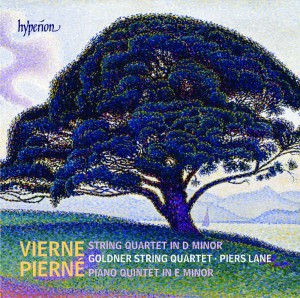 De twee Franse componisten Gabriel Pierné en Louis Vierne staan centraal in de opnames die het Goldner String Quartet in 2013 maakte samen met de pianist Piers Lane; nu ook uitgebracht op CD. Hoog melodische Franse muziek uit het begin van de 20ste gecomponeerd voor pianokwintet en strijkkwartet door respectievelijk door Pierné en Vierne.
De twee Franse componisten Gabriel Pierné en Louis Vierne staan centraal in de opnames die het Goldner String Quartet in 2013 maakte samen met de pianist Piers Lane; nu ook uitgebracht op CD. Hoog melodische Franse muziek uit het begin van de 20ste gecomponeerd voor pianokwintet en strijkkwartet door respectievelijk door Pierné en Vierne.
English version below
Beiden componisten hebben min of meer geleden onder hun eigen succes. Pierné was een veelgevraagd dirigent en Vierne een gevierd organist van o.a. de Notre Dame in Parijs. Hierdoor kwamen beiden componisten nauwelijks toe aan het uitvoeren van hun eigen werk. Ze studeerden in Parijs en hebben beiden les gekregen van César Franck wat tot uiting komt in de chromatiek die ze gebruiken in hun muziek.
Gabriel Pierné (1863-1937) draagt zijn Piano Quintet in E-minor (Op.41) op aan Gabriel Fauré. Een werk waarin de piano prachtig mêleert binnen de vier strijkers. In het begin van het eerste deel zijn de vier strijkers zelfs een orkestratie van de pianopartij. Langzaam ontvouwt dit deel zich als een rijk gekleurde bloem die behoedzaam openklapt, met een markante Debussy invloed. Pierné, die geïnspireerd was door de Zortzico, gebruikt deze Baskische dans (in 5-tels maat) als basis voor het tweede deel. Hierdoor legt dit deel zelfs een link naar de muziek van Nationale Scholen. In het derde deel horen we de diverse thema’s terug in allerlei variaties met veel gebruik van chromatiek die de invloed van César Franck verraadt. De muziek van Pierné is transparant en helder gecomponeerd en wordt voortreffelijk gespeeld door het Goldner String Quartet en pianist Piers Lane. Steeds met de juiste dosering klinken thema’s tegen een organische afwisseling van verschillende timbres. Dat vergt kwaliteit en een eenduidige interpretatie!
Louis Vierne (1870-1937) wordt geboren in Poitiers in 1870, bijna blind. Zijn String Quartet in D minor componeerde hij in 1894 waarin hij zich een meester toont in melodie en harmonie, goed hoorbaar in het eerste deel waar zelfs inzetten à al Bach en sequensen hoorbaar zijn. De speelsheid met springende melodieën (met een knipoog naar Grieg’s ‘Holberg Suite‘) en lange harmonische lijnen vinden we terug in respectievelijk het tweede en derde deel. Het slotdeel ‘Allegro vivace‘ heeft dezelfde opbouw als de andere delen, met twee contrasterende thema’s waarvan het beginthema terugkeert en dit vierde deel zelfs op een rondo-vorm lijkt, gevolgd door korte fugatische inzetten. Dit Strijkkwartet in d-mineur eindig met een D-majeur akkoord. Een ferm slot dat we een ‘picardische terts’ noemen, veelal gebruikt in de Barok periode. De muziek klinkt sonoor en wordt gespeeld met de juiste dynamiek en energie. Nergens over de top maar steeds prachtig in balans. Het Australische Goldner String Quartet bestaat deze zomer (2015) twintig jaar. Een mooi prestatie die met deze uitgave nog extra feestelijk wordt!
English version
The two French composers Gabriel Pierné and Louis Vierne are central on the album by the Goldner String Quartet and pianist Piers Lane, recorded in 2013; also released in the Netherlands. Highly melodic French music from the early 20th composed for piano quintet and string quartet respectively composed by Pierné and Vierne.
Both composers have more or less suffered from their own success. Pierné was much in demand as a conductor and Vierne celebrated as an organist at the Notre Dame Cathedral in Paris. Both composers were barely able to carry out their own work. They both studied in Paris with César Franck which is reflected in the chromaticism they use in their music.
Gabriel Pierné (1863-1937) dedicates his Piano Quintet in E minor (Op.41) to Gabriel Fauré. A composition in which the piano beautifully mingles in the four strings. At the start of the first piece, the four strings are even an orchestration of the piano part. Like a slowly unfolding lovely colored flower that gently opens, with a striking Debussy influence. Pierné, who was inspired by the Zortzico used this Basque dance (in five-beat) in his second part. Therefore this piece even puts a link to the music of National Schools. In the third piece we hear several themes return in many variations with the frequent use of chromaticism; the influence of César Franck. Pierné’s music is transparent, clear and excellently played by the Goldner String Quartet and pianist Piers Lane, with an organic variety of different timbres. This requires quality and an uniform interpretation!
Louis Vierne (1870-1937) was born in Poitiers in 1870, almost blind. In 1894 he composed his String Quartet in D minor in which he shows to be a master of melody and harmony, clearly audible in the first part where even the influence of Bach and sequences can be heard. Joyful music with catchy melodies (with a eye-wink to Grieg’s ‘Holberg Suite‘) and long harmonic lines can be found respectively in the second and third part. The final movement ‘Allegro vivace‘ has the same structure as the other parts, with two contrasting themes of which the first theme is played over and over again that it might get into a rondo, followed by short fugue parts. The String Quartet in D minor finishes with a D-major chord. A firm conclusion that we call a ‘Picardy third‘, often used in the Baroque period. The music is played with excellent dynamics and energy. Beautifully balanced. The 20th Anniversary party of the Australian Goldner String Quartet this summer (2015) might even get bigger with such a lovely release!
- Goldner String Quartet – Piers Lane: ‘Vierne and Pierné‘ (Hyperion Records / Harmonia Mundi)
© Mattie Poels.

Geen reacties